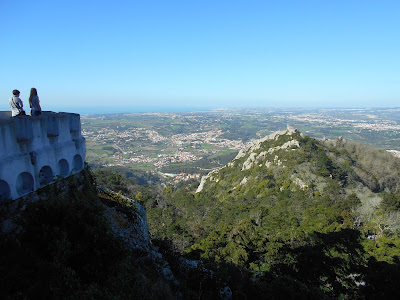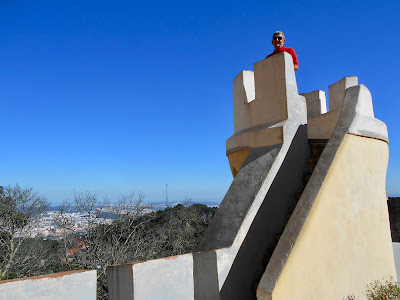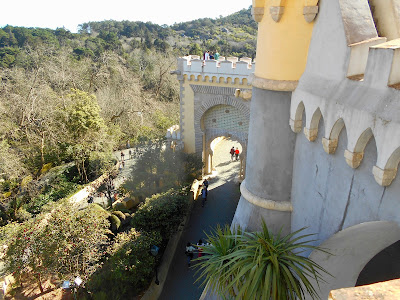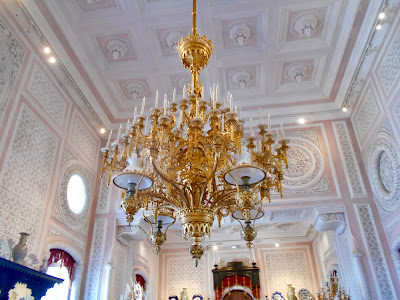While we were in Lisbon we ventured outside of the city to tour Sintra's Pena Palace. This fairyland palace with it's gorgeous exterior, spectacular mountain-top views and sumptuous interior is one of the most spectacular we've ever visited.
Getting to Sintra is easy via the direct train that leaves from Lisbon's Rossio train station. Upon arrival in Sintra the 434 bus winds its way to the top of the mountain. It is an adventure in its own right as it involves numerous hairpin turns that require bus drivers to fold in their side rearview mirrors while a second person exits to direct traffic as the bus inches its way up the rugged mountain. A traffic plaza at the end of the line allows buses, taxis, cars and tuk-tuks to turn around for the return trip while clerks at the admission booth explain there is an optional mini-bus ride to the palace proper. (Translation: we've not yet reached the summit!)
While those younger and in better shape could do it on foot I was glad of the extra service and John didn't complain either as upon exiting the mini-bus we still had a fair walk up hill to the main gate.
The detail and carved decoration of the stone gate adds to the fairytale feel.
Crossing over the drawbridge that is just inside the gate one follows a winding, covered arched walkway that is another steep incline. (It's all uphill!)
John stopped to admire this little garden focal point.
 |
| The drawbridge |
Once inside the palace proper there are ample places to take a few moments to catch one's breath or stop and admire the incredible views of this UNESCO World Heritage Site as well as grab a beverage, snack or souvenir. In summer this area would have a canopy to provide additional shade for visitors.
Walkways around the palace offered incredible vistas and photographic opportunities as well as providing a sense of the size of the palace.
 |
| Built onto the rock |
 |
| Moorish Castle on hillside to the right |
 |
| Close-up |
 |
| Sintra in the valley below |
Meanwhile inner courtyards of the palace provide shady spots to read, relax or get one's bearings.
Parts of the exterior are painted vivid colours while other walls are adorned with tile and carved stone work.
Slipping through the archway above we arrive at an even more detailed side of the building.
 |
| Dome ceiling |
This courtyards suggests the Mediterranean appreciation for outdoor spaces.
The original medieval building at Sintra was a chapel that later became a monastery to just 18 monks. Unfortunately, much of it was destroyed by the 1755 earthquake and left in ruins until the Portuguese royal family purchased it (and the surrounding land) in the 1830s with the intention of transforming it into a summer residence. Designed in the Romantic style and built between 1842 and 1854 the current chapel utilizes established Christian decor as well as the Portuguese love for azulejo.
Curved staircases take one up or down and these are far more likely to have been used by the staff rather than the royal family.
The entrance for visitors is somewhat more lavish!
The actual living quarters of the royal family were lavish, but surprisingly cozy. As one would expect these spaces included portraits and sculptures of loved ones.
Like the Tile Museum the Pena Palace was on our list of things to see during our weeklong stay in Lisbon and we're so glad we had the opportunity.
 |
| Alter |
 |
| Ceiling |
Curved staircases take one up or down and these are far more likely to have been used by the staff rather than the royal family.
The entrance for visitors is somewhat more lavish!
The actual living quarters of the royal family were lavish, but surprisingly cozy. As one would expect these spaces included portraits and sculptures of loved ones.
Furniture while bordering on obsessive and fussy was nonetheless functional.
As fine as the furnishings and rooms were, it was the vaulted ceilings that captivated me.
 |
| Mourning Glory Chandelier with mosaic dome |
The Great Hall, however, was the most majestic room of all.
There were 12 sitting areas in total, all utilizing the same design and style of furniture.
These lighting units could be confusing (and frightening) after a few alcoholic beverages. Just look at that angle!
The mirrored settees add comfort and help reflect the light.
The intricate ceiling and wall detailing made it all the more inviting.
In the basement is a spacious kitchen filled with copper pots, crockery, carboys and massive mortar and pestles - all waiting to serve the king, queen and their guests a delicious meal.
Like the Tile Museum the Pena Palace was on our list of things to see during our weeklong stay in Lisbon and we're so glad we had the opportunity.
* * *































































